
Caryophyllaceae, commonly called the pink family or carnation family, is a family of flowering plants. It is included in the dicotyledon order Caryophyllales in the APG III system, alongside 33 other families, including Amaranthaceae, Cactaceae, and Polygonaceae. It is a large family, with 81 genera and about 2,625 known species.

Gypsophila is a genus of flowering plants in the carnation family, Caryophyllaceae. They are native to Eurasia, Africa, Australia, and the Pacific Islands. Turkey has a particularly high diversity of Gypsophila taxa, with about 35 endemic species. Some Gypsophila are introduced species in other regions.

Sanguisorba is a genus of flowering plants in the family Rosaceae native to the temperate regions of the Northern Hemisphere. The common name is burnet.

Isatis is a genus of flowering plants in the family Brassicaceae, native to the Mediterranean region east to central Asia. Its genus name, Isatis, derives from the ancient Greek word for the plant, ἰσάτις. The genus includes woad. Due to their extremely variable morphology, the Asian species in particular are difficult to determine; the only reliable diagnostic feature is the ripe fruit. They are (usually) biennial or perennial herbaceous plants, often bluish and hairless or downy hairy with the upright stem branched.
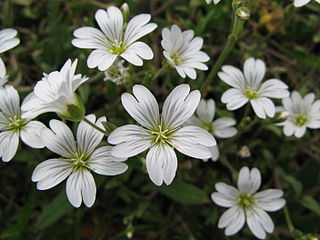
Cerastium is a genus of annual, winter annual, or perennial flowering plants belonging to the family Caryophyllaceae. They are commonly called mouse-ears or mouse-ear chickweeds. There are 214 accepted species, found nearly worldwide but with the greatest concentration in the northern temperate regions. A number of the species are common weeds in fields and on disturbed ground.
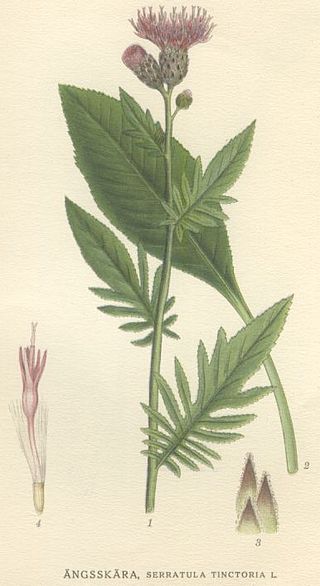
Serratula is a genus of plants in the tribe Cardueae within the family Asteraceae native to Eurasia. Plumeless saw-wort is a common name for plants in this genus. Serratula as traditionally defined contains at least two groups: one of which is basal within the subtribe Centaureinae and one of which is derived; the former group can be moved to the genus Klasea.
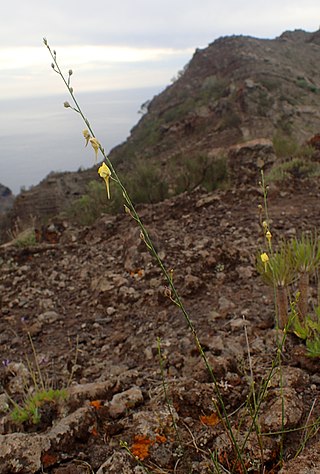
Nanorrhinum is a genus of flowering plants in family Plantaginaceae. It includes 29 species ranging from the Sahara and Sahel of northern Africa to the Arabian Peninsula, Iran, the Indian subcontinent, and Myanmar.

Tephroseris is a genus of Eurasian and North American plants in the groundsel tribe within the daisy family.
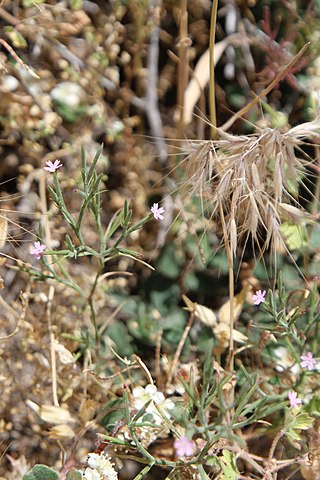
Dianthus nudiflorus, synonym Velezia rigida, is a species of flowering plant in the family Caryophyllaceae. It is native to the Mediterranean Basin countries of Europe and North Africa, and to western and central Asia and Pakistan. It is also present in northern California where it is an introduced species. It is an annual herb growing from a taproot and producing a hairy, glandular, branching green or purplish stem up to 40 centimeters tall. The linear leaves are up to 2 centimeters long. Solitary flowers occur in the leaf axils. Each flower has a very long, cylindrical, ribbed calyx of fused sepals forming the tubular throat of the flower, measuring at least a centimeter in length. At the top of the tube is the flower corolla which has five pink or purplish petals.

Acanthophyllum is a genus of flowering plants in the family Caryophyllaceae with about 75 species, spread in the Irano-Turanian area.
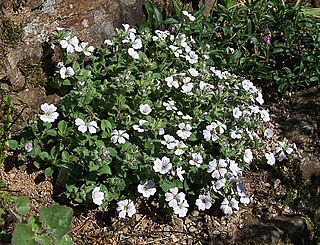
Acanthophyllum cerastioides, the chickweed baby's-breath, is a perennial plant of the family Caryophyllaceae, found in Bangladesh, Bhutan, North India, Nepal, North Pakistan, and Sikkim, with a typical height of 10–27 cm. Recent molecular studies show this species is a member of the genus Acanthophyllum rather than Gypsophila.

Nanorrhinum scoparium, synonym Kickxia scoparia, is a yellow-flowered plant native to rocky areas of the Canary Islands in the North Atlantic. It belongs to the plantain family (Plantaginaceae).

Balkana spergulifolia is a species of flowering plant in the carnation family, Caryophyllaceae. It is a subshrub native to the western Balkan Peninsula, including Albania, Bosnia and Herzegovina, and other neighboring former Yugoslav countries.

Eremogone is a genus of flowering plants in the family Caryophyllaceae, native to western North America, northern Asia, eastern Europe and northeastern Africa. Attempts to resolve taxonomic relationships within the Caryophyllaceae have resulted in the enlargement of Eremogone with species from other genera.
Psammogeton is a genus of flowering plants belonging to the family Apiaceae.
Petroana is a genus of flowering plants belonging to the family Caryophyllaceae Juss., established by Madhani & Zarre in 2018 based on molecular and morphological evidence that distinguished its species from those in the closely related genera Gypsophila L. and Dianthus L.. This genus includes perennial herbs characterized by their adaptation to rocky habitats, with two species currently recognized: the type species Petroana montserratii(Fern.Casas) Madhani & Zarre and Petroana montana(Balf.f.) Madhani & Zarre.
Schizotechium is a genus of flowering plants in the carnation family, Caryophyllaceae. It includes six species, which are native to central, south, and southeastern Asia and to western North America.













